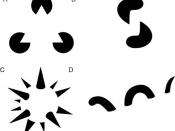The purpose of this paper is to discuss Gestalt psychology including its origin, the people responsible for its development, and some of the basic principles or laws of Gestalt.
Gestalt began in Germany at the start of the 20th century during the time when structuralism was the dominant approach to dealing with perception. The structuralists believed that perception was created by a number of sensations that when combined would form the basis for the whole perception. Max Wertheimer, considered to be the father of Gestalt, thought the approach was wrong and came up with the concept that the whole was more important that the individual sensations (Goldstein, 178). Wertheimer used two research students, Kurt Koffka and Wolfgang Kohler, to help him in his work and who later came to be known as the three founders of Gestalt psychology (Gestalt). The German name "Gestalt" relating to form or configuration, continues to be used as the name of this approach because there is no exact English translation.
Gestalt is used to explain perception and perceptual organization.
Unlike the structuralism view of perception that used a bottoms up approach by adding up the parts, Gestalt stressed the importance of the whole as being more important that the sum of its parts. We often hear the phrase "The whole is often greater than the sum of individual parts," as one of the principals associated with Gestalt psychology. It is not the collection of individual pieces, but the interpretations of the whole that is important (Baron and Byrne, 65). To add to the importance of viewing the whole, Gestaltists developed a set of principles or laws of perceptual organization that explain how we organize small parts into wholes (Goldstein, 180). There are seven laws of Gestalt used to describe how we interpret what we see.


